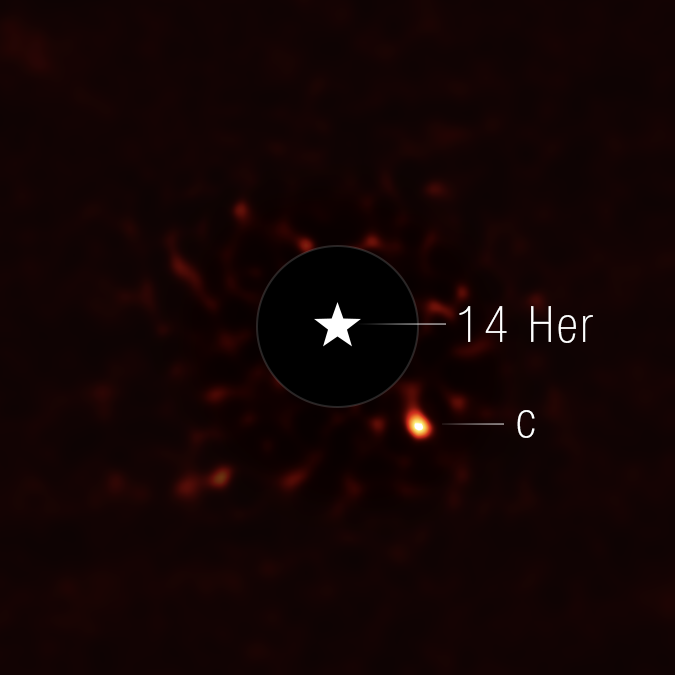1 min read
14 Herculis c (NIRCam)

This image of 14 Herculis c, a planet orbiting a star 60 light-years away from Earth, was taken with the coronagraph on NASA’s James Webb Space Telescope’s NIRCam (Near-Infrared Camera). A star symbol marks the location of the host star 14 Herculis, whose light has been blocked by the coronagraph (shown here as a dark circle outlined in white).
Observations from Webb suggest the exoplanet, 14 Herculis c, is as cool as 26 degrees Fahrenheit, marking it as one of the coldest exoplanets ever imaged. Findings also indicate the planet orbits around 1.4 billion miles from the host star in a highly elliptical, or football-shaped, orbit, closer in than previous estimates. The planet was not as bright as researchers expected based on its known age (around 4 billion years old) or mass (about 7 times the planet Jupiter). This leads researchers to believe there are complex atmospheric dynamics at play where molecules made at warmer temperatures in the lower atmosphere are brought to the cold, upper atmosphere very quickly.
Light at 4.44 microns was assigned to the color red in this image.
About the Object
- R.A. PositionR.A. PositionRight ascension – analogous to longitude – is one component of an object's position.16:10:24.61
- Dec. PositionDec. PositionDeclination – analogous to latitude – is one component of an object's position.+43:48:56.26
- ConstellationConstellationOne of 88 recognized regions of the celestial sphere in which the object appears.Hercules
- DistanceDistanceThe physical distance from Earth to the astronomical object. Distances within our solar system are usually measured in Astronomical Units (AU). Distances between stars are usually measured in light-years. Interstellar distances can also be measured in parsecs.About 60 light-years away
About the Data
- Data DescriptionData DescriptionProposal: A description of the observations, their scientific justification, and the links to the data available in the science archive.
Science Team: The astronomers who planned the observations and analyzed the data. "PI" refers to the Principal Investigator.This image was created with Webb data from proposal: 3337 (D. C. Bardalez Gagliuffi). Image processing: Alyssa Pagan (STScI).
- InstrumentInstrumentThe science instrument used to produce the data.NIRCam
- Exposure DatesExposure DatesThe date(s) that the telescope made its observations and the total exposure time.18 May 2024
- FiltersFiltersThe camera filters that were used in the science observations.F444W
- Object NameObject NameA name or catalog number that astronomers use to identify an astronomical object.14 Herculis c
- Object DescriptionObject DescriptionThe type of astronomical object.Cold exoplanet
- Release DateJune 10, 2025
- Science ReleaseFrigid Exoplanet in Strange Orbit Imaged by NASA’s Webb
- CreditImage: NASA, ESA, CSA, STScI, William Balmer (JHU), Daniella Bardalez Gagliuffi (Amherst College)

This image is acquired by the NIRCam instrument on the James Webb Space Telescope. The color results from assigning a warm/red color map to a monochromatic (grayscale) image.
Share
Details
Laura Betz
NASA’s Goddard Space Flight Center
Greenbelt, Maryland
laura.e.betz@nasa.gov
NASA, ESA, CSA, STScI, William Balmer (JHU), Daniella Bardalez Gagliuffi (Amherst College)






























